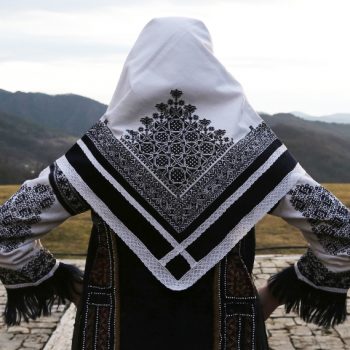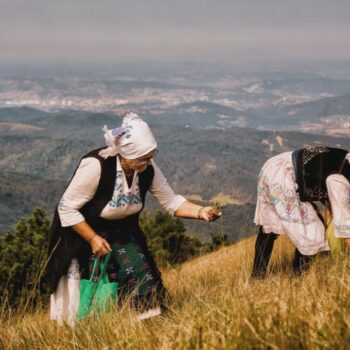Zmijanje embroidery

To stay warm, people in ancient times discovered ways to spin cotton, wool, flax and hemp into thin threads. By weaving these threads, they created textiles, clothing and household items. The weaving process has remained almost unchanged to this day, and looms were once a staple in every household. Each family infused the woven products with motifs from their region. These fine threads became part of the oldest hand embroidery on the Balkans, the Zmijanje Embroidery.
Since the mid-19th century, this embroidery has retained its dark blue color and cross-stitch technique on fabric. The motifs represent the “Kolo/Krajina Dance”, a central element of the embroidered decorations, featuring floral and rhombus shapes symbolizing family, hearth and faith in togetherness. Embroidered items can be found at the Heritage Association “Zmijanje,” KUD “Ribnik,” Humanitarian Women’s Association “Duga,” in souvenir shops in Banja Luka and similar places.
The Picking of Iva (germander) on Ozren

The custom and centuries-old tradition of “Picking Iva (germander) on Mount Ozren” preserves the region’s traditional clothing, songs and dances. Every year at the end of summer, on September 11 – the day of the Feast of the Beheading of St. John the Baptist, the residents of Petrovo, Doboj and nearby areas gather at Gostilj. Locals believe in the saying, “With germander even the dead get better” and it is thought that grass picked on this day holds miraculous powers, making this area truly unique.
The Tradition of Breeding Lipizzaner Horses

Lipizzaner horses are rare, relatively small in stature, of robust build and noble appearance, recognizable by their graceful walk, high-stepping action and beautifully arched “swan” necks. They are born dark blue or black, but most change color to light gray or white as they mature.
For centuries, they have been cherished by riders, horsemen and European nobility for dressage riding. Originally bred for the Habsburg Imperial Court, the breed was established in 1580. At the Vucijak Stud Farm near Prnjavor, all the horses trace their lineage back to the breed’s founders from 1580. These remarkable horses, used for therapeutic riding, dressage, carriage driving, carnival processions and parades, carry the legacy of over 450 years of dedicated caretakers, crafters, local communities and farm visitors.


